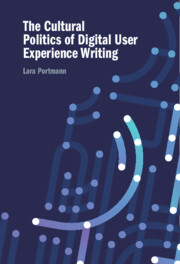Refine search
Actions for selected content:
5 results
2 - Designing Words
- from I - Mapping the Profession: The Language Work of UX Writers
-
- Book:
- The Cultural Politics of Digital User Experience Writing
- Published online:
- 24 July 2025
- Print publication:
- 07 August 2025, pp 29-54
-
- Chapter
- Export citation
6 - Crafting an Audience
- from III - Producing Little Texts
-
- Book:
- The Cultural Politics of Digital User Experience Writing
- Published online:
- 24 July 2025
- Print publication:
- 07 August 2025, pp 139-158
-
- Chapter
- Export citation
5 - (De)Constructing the Invisible Interface
- from III - Producing Little Texts
-
- Book:
- The Cultural Politics of Digital User Experience Writing
- Published online:
- 24 July 2025
- Print publication:
- 07 August 2025, pp 111-138
-
- Chapter
- Export citation

The Cultural Politics of Digital User Experience Writing
-
- Published online:
- 24 July 2025
- Print publication:
- 07 August 2025
10 - Human-Centered Data Analytics for Cybersecurity
-
- Book:
- Data Analytics for Cybersecurity
- Published online:
- 10 August 2022
- Print publication:
- 21 July 2022, pp 137-146
-
- Chapter
- Export citation
